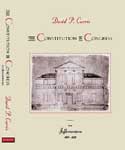Currie surveys the Constitution throughout the Jeffersonian period
By Peter SchulerNews Office
 |
“I have long been convinced that in focusing so heavily on judicial decisions, those who think about the Constitution from a legal perspective have paid too little attention to other sources of insights into its interpretation,” Currie explained.
Currie also has written The Constitution in Congress: The Federalist Period, 1789-1801, and the award-winning, two-volume history, The Constitution in the Supreme Court, both published by the University Press.
In his first book, examining the Federalist Period, Currie concluded that the first 12 years of the U.S. Government, when the Federalists were in control, saw the legislative and executive branches rather than the courts take the lead in the original interpretation of the Constitution.
 |
“Like the Federalist era that preceded it, the Jeffersonian years were a defining period in American constitutional history. The best minds in the country grappled with practical questions of applying the generalities of the Constitution to concrete and often unforeseen circumstances,” Currie said.
Currie’s focus has been to study congressional and executive history from a legal perspective. “I disclaim any pretension to improve upon the work of historians and political scientists who have studied this period,” Currie said. “However, I believe that Congress and the executive branch have a great deal to tell us about what the Constitution means.”
Though federal judges became increasingly active during the Jeffersonian years, the groundwork for their decisions was created in extensive legislative and executive discussions of the measures under review. The Jeffersonian years witnessed great controversies like the abolition of the circuit courts, the Louisiana Purchase, the Burr conspiracy, the War of 1812, the Missouri Compromise and the Monroe Doctrine.
Currie has methodically worked his way through the key documents of the period, including federal statutes, congressional debates, presidential messages and the decisions of the Supreme Court. “One chief justice at a time,” Currie added. “This enabled me to see not only the chronological development of particular areas of law but also horizontal relationships between things happening in different fields of constitutional law in a given period.”
Currie noted that the development of the Constitution could be seen in the multitude of small decisions the executive and judicial branches confronted daily. “The Constitution was interpreted by members of Congress and by numerous executive officers, up to and including the President. Whenever a federal official proposed to take a particular action,” Currie said, “he always had to ask himself, ‘Is it Constitutional?’”
“In the early days,” Currie said, “there was no argument over whether the Constitution should be interpreted in accordance with the framers’ original intentions. Everyone agreed that it should. The only questionˇand the answer was often not obviousˇwas what the framers had intended.”
![[Chronicle]](/images/small-header.gif)